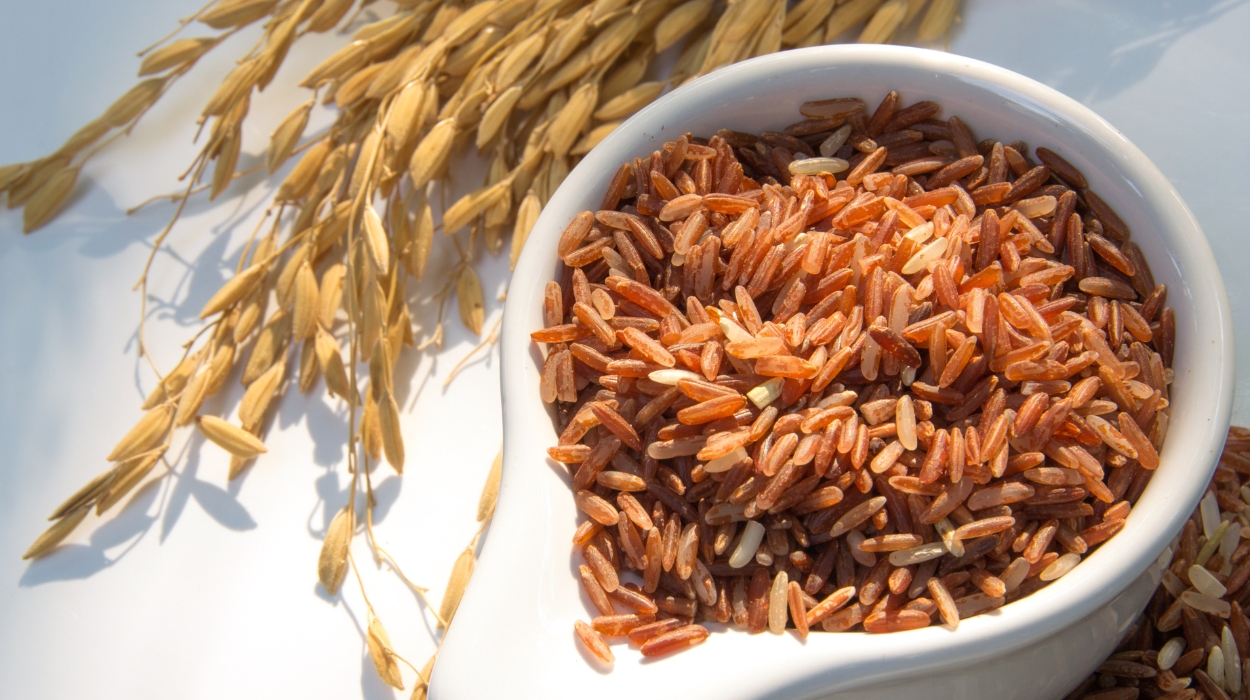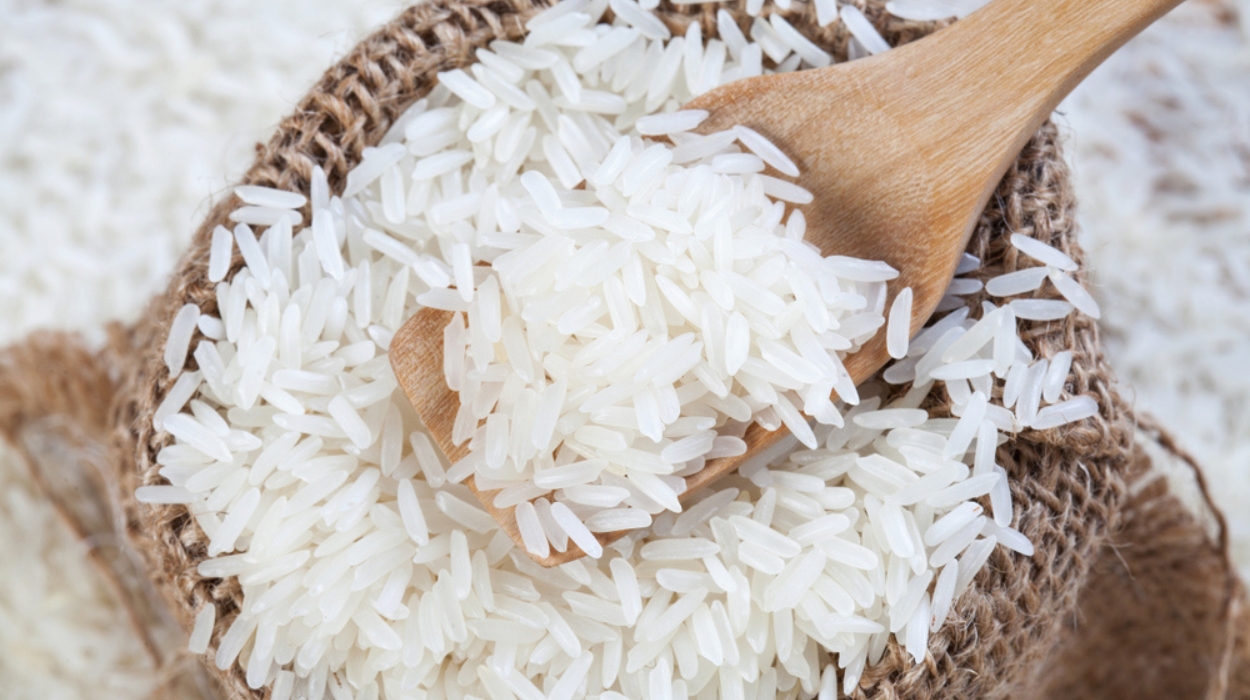Rice is a staple of almost every meal. This grain readily completes numerous dishes, much to the delight of millions of people worldwide. Its incredible adaptability makes it compatible with various meals, including those native to Asia, Africa, Europe, and the Americas.
Interestingly, rice has been a staple diet for several millennia; historians trace its origins to 2500 B.C.[1] With roughly 10.79 million tons[2] projected to be produced in 2023/24, it is still considered a staple food by more than half of the world’s population.
But can rice help you live a healthy lifestyle? Is rice good for weight loss? In this article, we examine the role of rice in weight loss and how you can use its benefits to achieve a healthy weight.
Is Eating Rice Good For Weight Loss?
Yes, rice fits into the diet requirements of a weight loss plan and can even help with weight loss if eaten in moderation. Although high in carbohydrates, the grain is low in calories and lipids. Brown rice is particularly beneficial for weight loss since it is abundant in fiber, prolongs satiation, supports intestinal health, and partially inhibits fat storage.
Is Rice Good For Weight Loss?

Eating rice does not guarantee weight loss, but it can be included in a diet designed specifically for achieving a healthy weight. Low-carb diets frequently eliminate rice. It is regarded as a weight gain promoter in some cultures due to its high carbohydrate content in a small amount of food. However, many people are unaware that rice is not the alleged culprit in weight loss.
If anything, it is the sustenance individuals wishing to lose weight should seek. Rice is high in carbs but low in calories;[3] thus, it does not necessarily interfere with weight loss efforts. Carbohydrates are good since they supply energy to the brain and muscles.[4] By sustaining and increasing energy, rice carbohydrates promote weight loss by decreasing the need and desire for frequent meals.
Rice, a complex carbohydrate,[5] aids in the maintenance of steady energy levels throughout the day, thereby meeting the energy requirements of persons surviving on limited food quotients.
Anti-Obesity Properties Associated With Rice
A 2022 study revealed that rice has anti-obesity capabilities[6] in high-fat diets. In this regard, grain is preferable in managing obesity and its associated problems. It has a higher potential for good benefits than some dietary alternatives, mainly where people are prone to food-induced weight gain from a high-fat diet.
Rice, for example, is a wonderful weight loss alternative in the United States, where many obese individuals are victims of junk food. Rice is low in fat, unlike the fatty meals prevalent in U.S. food markets.
The Nutritional Profile Of Quality Rice
Rice is considered helpful for weight loss due to its nutritious benefits and low calorie and fat content. Rice has a variety of vitamins and minerals[7] that can help you lose weight. Its high fiber content is very advantageous to the weight loss experience because it aids in the digestive element of weight loss. Brown rice has a whopping 3 grams of fiber per 100 grams of rice.
The resistant starch inhibits digestion[8] and the final emptying of the stomach. As a result, it helps to prolong the sense of satiation, thereby decreasing blood sugar surges and helping weight management.
To ensure you get enough fiber daily, choose brown rice over white. Fiber helps support gastrointestinal function and reduces the frequency of sugar spikes.
Some people include high-value ingredients such as garlic, broccoli, and healthy fats like olive oil, resulting in a healthy and delicious dinner that pairs well with a keto supplement for weight loss. Rice can be part of a healthy diet plan, whether a major course or a side, but is generally not compatible with a keto diet. Using it in very small amounts with a keto supplement might make it acceptable to the meal plan.
However, persons on a weight loss program should take their time when looking for high-quality rice[9] low in the contaminant arsenic. Eating rice of superior quality without contaminants increases the likelihood of reaching the intended weight reduction objectives since it minimally interferes with the food’s ability to metabolize foods.
Potentially hazardous substances, including genetically modified organisms or GMOs, sodium, gluten, and cholesterol, are absent from quality rice. People looking to minimize their risk of developing both acute and chronic illnesses may consider making quality rice the staple food of their weight loss program.
What’s In Rice?
Rice varieties come with their own nutritional profile. To understand the nutritional makeup of rice, one must first understand the composition of the individual type. People primarily harvest brown rice directly from the water-logged fields. Wild rice is also available in portions of Canada, the United States, and the Atlantic and Gulf coasts. The hue of wild rice is dark.
Brown and white rice are both complex carbohydrates. Each grain contains three edible components:
- Bran —The fibrous outer coat that covers the seed.
- Germ —The layer rich in nutrients.
- Endosperm —The center. It is high in carbohydrates and protein.
Brown rice is not necessarily a variety but rather raw rice that retains its original color. The bran and germ are still present, and only the inedible husk is lost. White rice is typically made from brown rice.
The bran and embryo are removed during polishing, leaving only the white endosperm. This becomes a refined carbohydrate with a high glycemic index and a more pronounced effect on blood sugars.
What Is The Difference Between Brown And White Rice?
The distinction between brown and white rice extends beyond physical characteristics to include nutritional considerations. White rice lacks some of brown rice’s natural nutrients, such as fiber, B vitamins, phytochemicals, and minerals. Conversely, rice manufacturers add iron and B vitamins to make the rice more nutritious, referred to as ‘enriched’ rice.
Processed rice is less nutritious than natural brown rice because manufacturers only add a small quantity of essential nutrients. Nonetheless, processing rice enhances its flavor, extends its shelf life, and improves its cooking qualities. However, is white rice good for weight loss even though some components are missing?
White rice is less nutritious than natural brown rice. Thus, it may not help with weight loss as effectively as its high-fiber counterparts, but it is lower in calories. According to the United States Department of Agriculture,[10] 100 grams of cooked white rice contains:
- 143 calories.
- 2.86 gram protein.
- 31.4 g of carbohydrates.
- 0.34 grams iron content.
The average rice consumption per serving is approximately one-half cup or 87 grams. Brown rice contains 366 calories for a 100-gram serving[7] and 77.7 grams of carbohydrates with 3 grams of fat, much higher nutrient values than white rice. Brown rice has more than double the calories of white rice per 100 grams.
Nonetheless, white rice has a deficient nutritional profile. Processed rice lacks other nutrients that aid in weight loss, particularly fiber. As a result, it is not considered the best option for people trying to lose weight despite the calorie difference.
Which Type Of Rice Is Good For Weight Loss?

Brown rice is excellent for people trying to lose weight if portion control is used. Brown rice’s nutritional content reflects a food ideal for weight reduction (in small amounts).
Brown Rice Has A High Fiber Content
Brown rice is high in fiber. It is cooked whole grain, which preserves the outer bran and germ. The fiber content, approximately 3.0 grams[7] for every 100 grams serving, is much higher than that of white rice. Brown rice has nearly four times the fiber content of white rice, which is 0.4 grams[11] for every 100 grams.
Aside from digestion, fiber aids in reducing low-density lipoprotein cholesterol (bad cholesterol) levels. According to a recent study, dietary fiber helps trap bad cholesterol,[12] blocking its absorption into the body. Reducing LDL cholesterol improves heart health and lowers the risk of hypertension, which is especially essential for persons who embark on cardio to lose weight.
Consuming fiber-rich whole-grain rice may also help reduce inflammation[13] by increasing gut strength. It reduces the risk of arthritis, which is critical for people who prefer to lose weight through strenuous exercise.
Brown Rice Extends The Feeling Of Fullness
Brown rice’s outer layers take longer to cook, which is a drawback for hurried cooks. However, the satiation is also lengthier and well worth the wait. The germ and outer bran make brown rice chewier, resulting in a longer mastication period. Food that takes longer to chew naturally inhibits eating huge servings.[14]
Brown Rice’s Low Glycemic Index
Dietitians are concerned with how quickly each food on a weight loss diet affects blood sugar levels. Foods that are digested and absorbed too quickly raise blood sugar levels and are said to have a high glycemic index. As a result, they cause fat storage and increase the risk of obesity.
Brown rice, on the other hand, is naturally suited for slow digestion and absorption, making it the greatest choice for dieters. Brown rice, unlike processed grains, has a low glycemic index.[15]
Disease-Fighting Properties Of Black Rice
In terms of weight loss appropriateness, brown rice, and wild rice take the lead. They are the ideal rice for a weight loss diet plan since they are whole grain and high in fiber.
For example, the black and red rice variants contain disease-fighting characteristics, providing more significant advantages than others. According to a 2018 study, Thai and Indonesian black rice have higher antioxidant levels[16] than other types.
How To Eat Rice For Weight Loss?
Rice is eaten in various ways by people from many cultures, including boiling, fried, in yogurt, with curries, in stews, and many other ways. While following one’s taste is not bad, dietitians and food specialists establish ground rules within which each cook must operate for the diet plan to function correctly.
Portion Control
Those following a weight loss plan must adhere to portion control to stay within their calorie deficit. To create a calorie deficit, one must eat consistently; otherwise, weight loss becomes an illusion.
Cooked rice typically increases three times the amount of uncooked grains and is high in energy. As a result, persons looking to lose weight should try to keep the rice ingredient to the recommended half cup,[17] or 100 grams. Eating this modest portion can compensate for the calories lost if one walks more than the recommended daily miles per day to lose weight.
Being attentive to the amount ingested regularly is critical for weight loss. In actuality, consuming a lot of rice, particularly white rice, can easily lead to metabolic syndrome and diabetes,[18] among other negative outcomes. Portion sizes if you have diabetes[19] may be limited to one-third of a cup using the carbohydrate exchange list.
Keeping track of how much you eat at each meal by keeping a food journal will help keep such troubles at bay while supporting your weight loss goals.
Food Pairing
Eating healthy goes beyond portion control. Another critical consideration is to pair rice with other foods that promote fullness and extend satiety. Food experts and dietitians say rice is best paired with lean proteins and vegetables.[20] These proteins and vegetables provide more fullness and satiety than most other forms of food, making them ideal for a weight loss diet intake.
Even better, they have a low glycemic index. Both lean proteins and vegetables have the potential to delay digestion, hence decreasing blood sugar spikes. Regarding glycemic index, consuming rice with the least impact on blood sugar levels is also important.
As previously stated, brown rice is the grain of choice for those on a diet. However, it is also vital to recognize that the cooking method and food temperature[21] impact the glycemic index.
Frying with seed oils,[22] for example, raises the glycemic index more than boiling because it introduces agents with a higher index. Similarly, heated rice is digested and absorbed faster than cool rice; the former elevates blood sugar more quickly.
People on a weight loss regimen should prepare rice beforehand to allow for cooling at low temperatures. If rice is chilled before eating, the molecules reorganize into resistant starch. As a result, it takes longer to digest and absorb, extending the satiety period.
Conclusion
Many people are unsure whether or not to eat rice when dealing with excessive weight and its consequences. The truth is that rice, like all other meals, has no miraculous weight loss abilities and might be harmful to health if consumed recklessly. However, if ingested correctly, rice can help with weight loss.
People on diets are recommended to eat whole-grain rice in small amounts. Rice, contrary to popular belief, can aid in weight loss by meeting nutritional requirements and protecting against potential complications.
Frequently Asked Questions
Yes. You can eat rice as long as you keep your daily quantities small enough to maintain a calorie deficit.
Yes. Rice, when ingested in appropriate portion sizes and in conjunction with a regular exercise routine, can help burn abdominal fat.
Half a cup of cooked rice, or around 100 grams, is sufficient to supply the energy and satiation required during the weight-loss period.
Yes, rice can be eaten every day. You must, however, exercise caution not to exceed the daily limit. Excessive consumption can result in additional weight gain.
No. Rice can be beneficial for weight loss since some brands are low in calories and fat while others are high in fiber. However, research suggests that overeating white rice can lead to metabolic syndrome, obesity, and other health problems.
Unprocessed brown rice is the finest option for losing weight. It is high in the nutrients required for weight loss, particularly fiber. But its higher calorie content prohibits large portion sizes.
Yes, you should buy whole grain rice, boil it, and let it cool before eating. It is also recommended to pair it with lean protein and vegetables for increased fullness and all-day satiation.
 Evidence Based
Evidence Based
